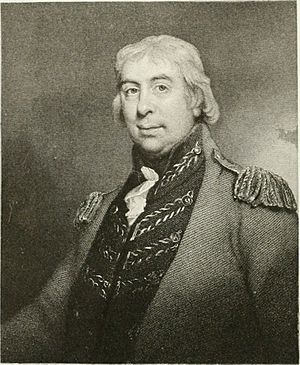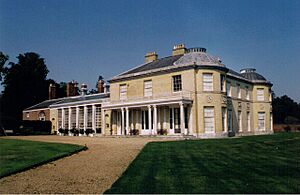George Harris, 1st Baron Harris facts for kids
Quick facts for kids
The Lord Harris
|
|
|---|---|

Lord George Harris GCB
|
|
| Born | 18 March 1746 |
| Died | 19 May 1829 (aged 83) |
| Allegiance | |
| Service/ |
|
| Years of service | 1760 - 1829 |
| Rank | Lieutenant General |
| Unit | Royal Artillery (1760-62) 5th (Northumberland Fusiliers) (1762-85) Madras Army (1786-92) |
| Commands held | Madras Army (1797-1800) 73rd (Highland) Regiment of Foot (1800-29) 2nd East Kent Regiment of Local Militia (1809-29) |
| Battles/wars | American Revolution |
| Awards | Knight Grand Cross of the Order of the Bath |
George Harris, 1st Baron Harris (born March 18, 1746 – died May 19, 1829) was an important British soldier. He became a Baron, which is a type of noble title, and was known for his military leadership, especially in India.
Contents
A Young Soldier's Start
George Harris was born in Brasted, Kent. His father was a church leader. George went to Westminster School and then to the Royal Military Academy, Woolwich. This is where he learned to be a soldier.
In 1760, he joined the Royal Artillery. This group uses cannons and other big guns. Two years later, he moved to the 5th Regiment of Foot. He quickly moved up the ranks, becoming a lieutenant in 1765 and a captain in 1771.
Fighting in America
Harris's first time fighting was during the American War of Independence. This was a war where the American colonies fought for their freedom from Britain. He fought in many important battles.
- He was at the Battle of Lexington.
- He fought at the Battle of Bunker Hill, where he was badly hurt.
- He was also part of battles like Battle of Long Island and Battle of White Plains.
By 1778, he had become a major. After America, he served in the Caribbean, fighting at Battle of St. Lucia. His regiment even served on ships for a while.
Service in India
In 1780, Harris became a lieutenant-colonel. He later moved to India with General Medows. He took part in many battles there. One important event was Lord Cornwallis's attack on Seringapatam in 1792. This was during the Third Anglo-Mysore War.
In 1794, Harris returned to India. He became a major-general that same year. By 1797, he was made the Commander-in-Chief of the Madras Army. This meant he was in charge of all the British troops in that part of India.
Victory at Seringapatam
In 1798, Lord Mornington, who was the governor-general, asked Harris to lead the army against Tipu Sultan. Tipu Sultan was a powerful ruler in India. In just a few months, Harris's army attacked and captured the strong city of Seringapatam. Tipu Sultan died defending his city. This victory was a huge success for the British.
For his success at Seringapatam, Harris received a lot of money. He was also offered a special noble title, but he said no at first. His victory made him famous as a skilled military leader.
Later Life and Legacy
Harris returned home to Britain in 1800. He continued to rise in rank, becoming a lieutenant-general in 1801 and a full general in 1812. In 1801, he bought a home called Belmont House in Kent.
In 1815, he was finally made a peer of the United Kingdom. This means he was given the title Baron Harris. His title was linked to his great victories in Seringapatam and Mysore. In 1820, he received another high honor, the GCB. He also became the governor of Dumbarton Castle in 1824.
Lord Harris died at Belmont in May 1829. His son, William, took over his title. One of his later family members, the 4th Baron Harris, became famous as a cricketer. He also held important government jobs, like Governor of Bombay.
Images for kids




